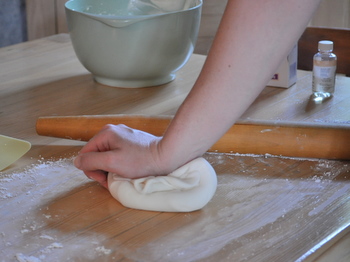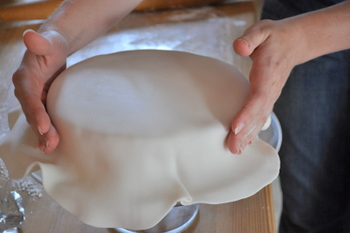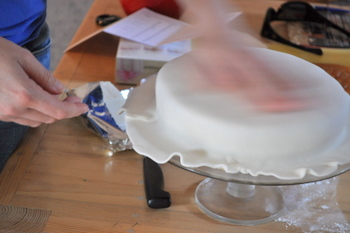
Covering a cake with fondant can seem intimidating if you’ve never tried it. It’s the same way that frosting a layer cake can seem intimidating if you’ve only ever spread frosting on top of a sheet cake that is still in the pan it was baked in. But just like getting past that first layer cake, covering a cake with fondant isn’t as difficult a task as it may seem, and it is a very useful skill to have if you want to engage in a little recreational cake decorating!
Before we get started, there are a few things to know. First, you can read all about what fondant is here. Fondant comes unflavored and doesn’t taste great on its own. You can add flavor to it by kneading in flavored extracts. Simply add a teaspoon or so of vanilla (or other flavors) and knead it until well incorporated, then continue as I describe below. You can add color by kneading in food coloring in the same way. You can buy it both colored and flavored. Here, I’m using a plain white fondant without flavoring.
Start with a cake that has been thoroughly cooled. Spread it with a thin layer of frosting, as though you’re making a crumb coat, and let it set before working with it. Don’t make the frosting too thick or the fondant may slide once it is applied. You can chill the cake for a few minutes to make it easier to handle if the icing is soft. When you’re ready to begin, assuming that you’re starting with packaged fondant, the first thing you do is lightly dust a smooth, clean work surface with cornstarch or confectioners sugar (I prefer confectioners’ sugar). Start kneading the fondant on the work surface until it is pliable.

Once it is pliable and easy to knead, roll it out into a big circle that is approximately 1/8th of an inch thick. Keep turning the fondant and add more cornstarch/sugar to the surface as needed to ensure that it does not stick. Feel free to try to go thinner if you are able to, but you still need to be able to move the fondant without it tearing, so thinner is not always better. The circle should be big enough to cover your cake, both top and sides. Estimate this size, then add about 2 extra inches all around.

Gently transfer the fondant to the cake, centering the piece of fondant in the middle of the cake. Rolling the fondant and then unrolling it is a popular method, as is draping the fondant carefully. Folding the fondant, as you might do for a pie crust, will create unsightly lines on the surface. Start at the center of the top of the cake and begin to push the fondant down and out towards the edge of the cake. This pushes out all the air bubbles and creates a smooth surface.

Push the fondant down the sides of the cake, smoothing and stretching as you go, until you reach the cake plate. Press the fondant firmly to “seal” it. When the cake is finished, take a sharp knife and cut off excess fondant around the edge of the cake. Do not reuse fondant that has had icing stuck to it, as it becomes very sticky and hard to work with. Now you can decorate you cake in any way you want to, whether you’re going to pipe on fancy icing decorations or paint a beautiful backdrop with edible food colorings!







Susie
July 9, 2010But where’s the trick for making fondant *taste* good? So pretty but so icky. Real question: is it really meant to be eaten or is it purely for decoration and expected to be peeled off? I heard people say it’s not meant to be eaten, if that’s the case, what’s the point?
Susie
July 9, 2010Although it is a great tutorial, not trying to be critical, I really just don’t understand fondant.
Nicole
July 9, 2010Susie,
No worries! I added a little clarification to the post about how to add color and flavoring. Fondant is definitely edible, but the cake itself will still be the star flavor-wise.
You can find out more about what fondant is here: http://bakingbites.com/2008/07/what-is-fondant/
Marian (Sweetopia)
July 10, 2010I’m so glad I stumbled accross your site! I’ve found another fave! It seems you have a sweet tooth as well. 😉
Suzanne
July 10, 2010I’ve made this marshmallow fondant several time and it tastes much better than regular fondant.
http://whatscookingamerica.net/PegW/Fondant.htm
It’s not hard to work with, either!
Sibelle
July 12, 2010Great tutorial! I have been decorating cakes for quite some time now, and I remember how frustrating the first few times covering a cake were.
A little tip: using cornstarch or sugar can leave stains on your fondant, so I prefer to use shortning. You can also use that to ‘repear’ minor tearing.
I know it is not common in the USA, but if you are really looking for a less sweet and edible alternative, use marzipan. I find it so much tastier and also easier to work with.
Linda
July 13, 2010These are great tips, I have tried fondant a few times but was not happy with the flavor and the results were not great so I will definitely try the Marshmallow Fondant – thanks,
Debbie
July 19, 2010Very informative but I have to agree with Susie … fondant can make a cake LOOK beautiful but I have never tasted one that improved the taste … in my opinion, it detracts. I made a fondant-covered cake for my daughter’s 6th birthday … it was adorable but NONE of the kids liked it, including the birthday girl … a COMPLETE bust! That was my first and last use of fondant! 🙂
Leah
July 22, 2010Great tutorial! I found my first few fondant cakes a real trial, I could never get the fondant on without it tearing. To be honest I still have issues years after my first cake.
I’m commenting more to highlight an odd difference between the US and UK in terms of fondant. Over here in the UK buttercream is used mainly by traditional bakeries but any cake decorator I know, the large supermarket cakes & anyone I know personally uses or expects fondant on decorated cakes. I use buttercream rarely, usually only when a client asks for it. Everyone I know much prefers the taste of fondant and many of my family and friends ask for a slice with the most fondant. We must have insanely sweet teeth (it is practically just sugar) or else the fondant you buy in the US is not as nice as ours!
I love hearing about food difference between countries and this particular difference has always confused me. Obviously just different tastes.
Marisa@make happy
August 6, 2010Fondant dislikers: try the marshmallow fondant! It’s very tasty, easy to make, and a dream to work with. I won’t use anything else.
Mary
August 30, 2010I have tried all the fondand always come back to marshmallow fondant. It is so easy to work with and so tasty! Last week I made a pair of ballet slippers to adorn a cake for a teenge girl’s birthday, and the girls ate the slippers as a snack after the cake was served!
ruth
November 19, 2010thanks. but how do i cover a cake with 2 layer? for instance a circle cake with a love shaped cake on top of it.is it seperate covering or you do it together with the rolled fundant? thanks.
Joan Wussow
May 10, 2012I only use Massa Grinchuna fondant from Albert Uster Imports. Everyone who tastes it relly likes it. It has a slight citrus flavor that balances the sweetness of the cake and frosting. Please try it!